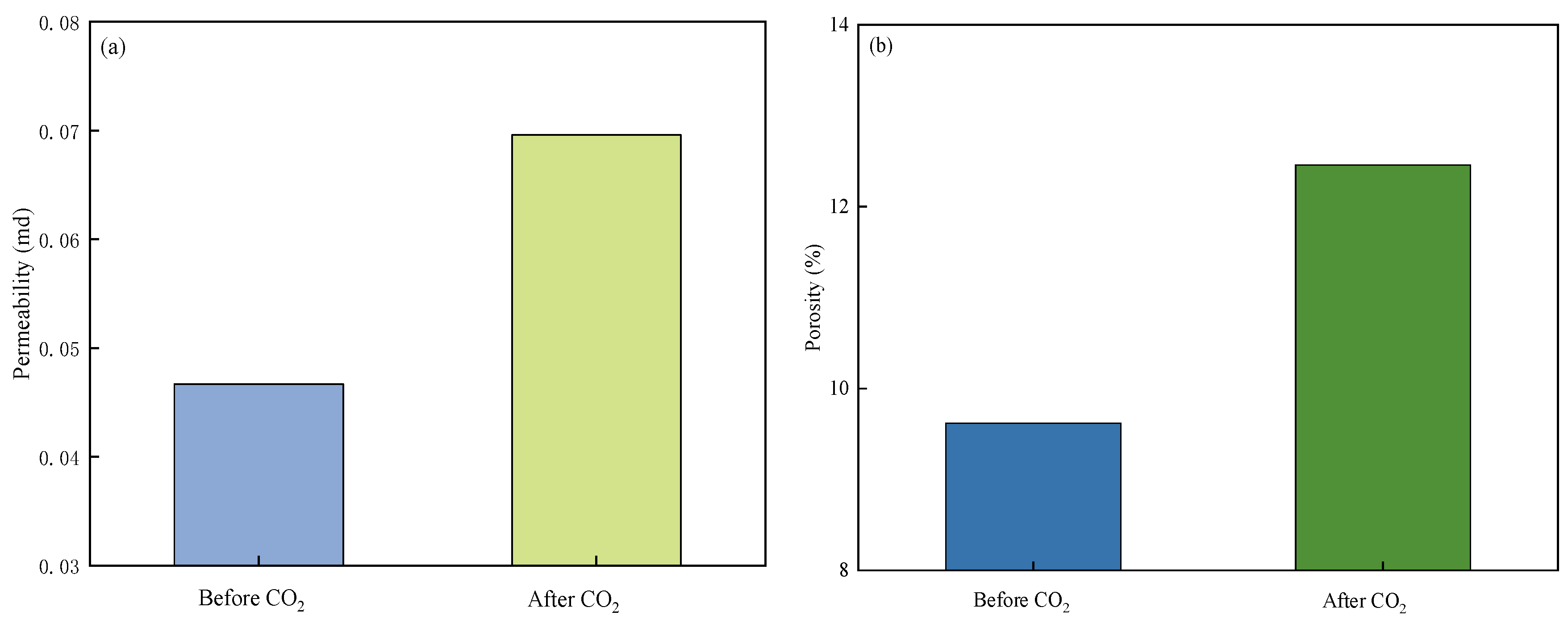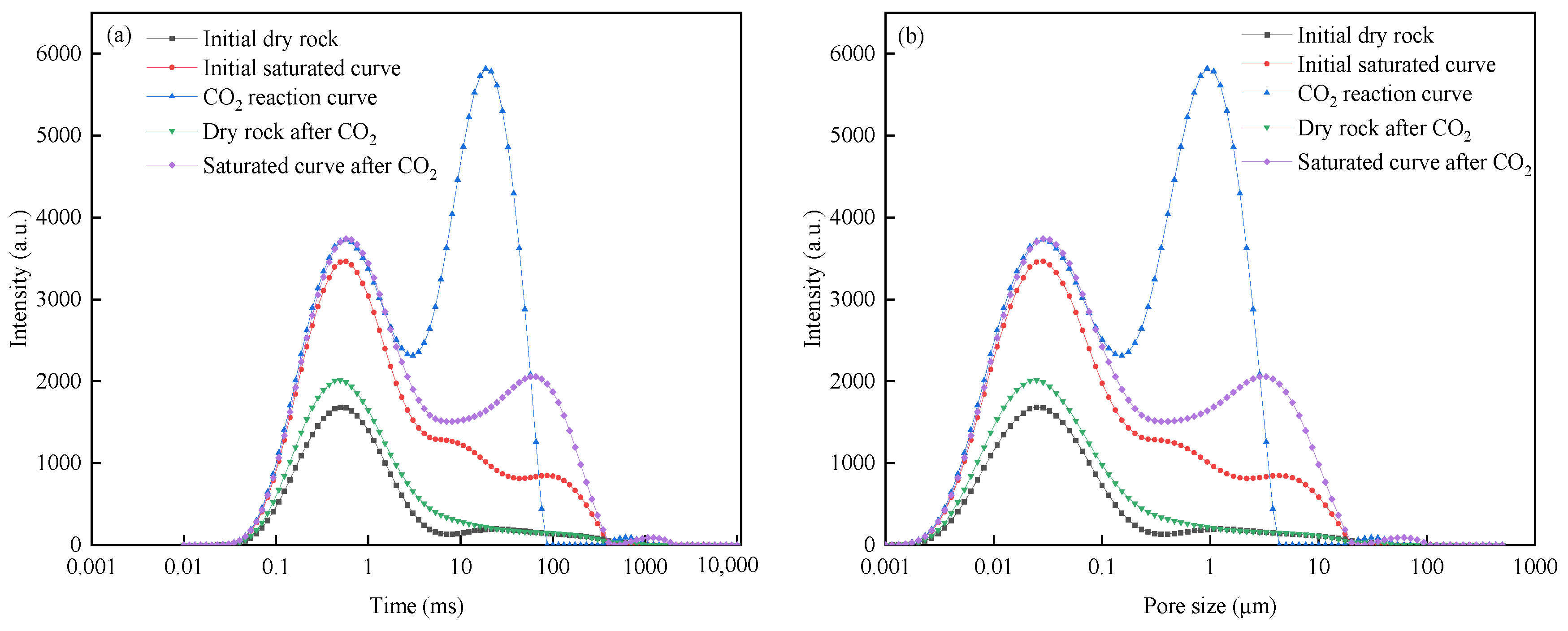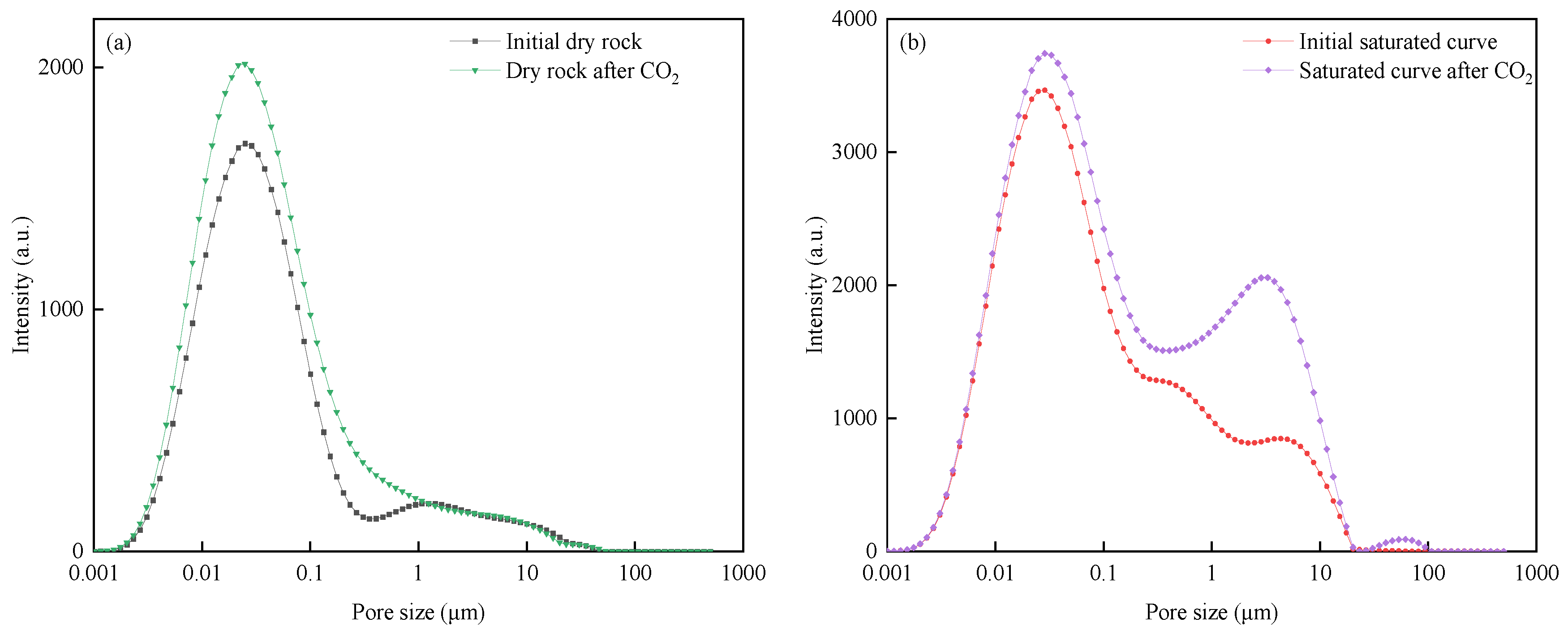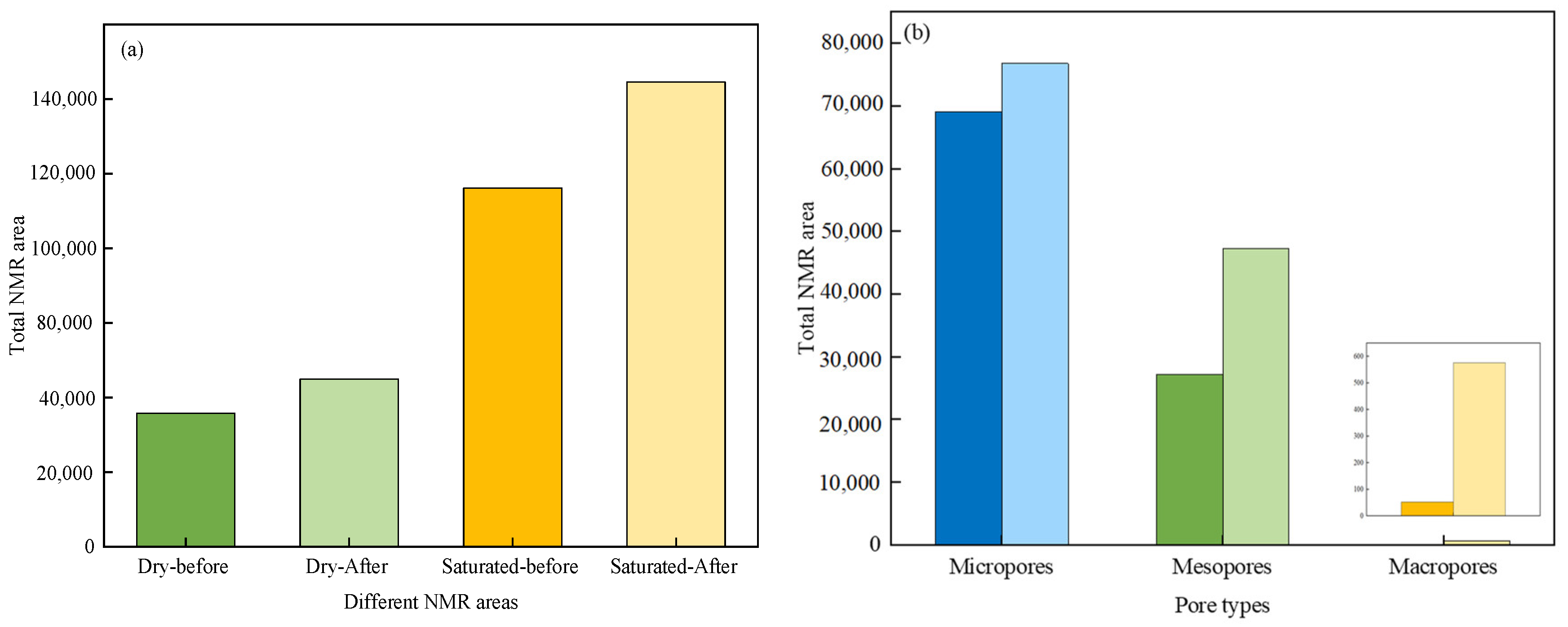Experimental Study on the Alteration in Pore Structure of Chang 7 Shale Oil Reservoirs Treated with Carbon Dioxide
Abstract
1. Introduction
2. Experiments
2.1. Materials
2.2. Experimental Scheme
2.3. NMR and LNA Experiments
3. Results
3.1. Changes in Physical Parameters of Shale Oil Reservoirs After CO2 Treatment
3.2. Change in Pore Structure of Shale Oil Reservoir Based on NMR
3.3. Changes in Pore Structure of Shale Oil Reservoir Based on LNA
4. Conclusions
- (1)
- The permeability and porosity of shale oil reservoirs in Ordos Basin increase after CO2 treatment. The permeability increases by 49.03%, and the porosity increases by 29.54%.
- (2)
- CO2 has a more significant impact on the pore structure of shale oil reservoirs. Our NMR results show that the micropores, mesopores, and macropores of reservoirs all increase under the influence of CO2. Furthermore, CO2 is more sensitive to the macropores, followed by mesopores and micropores.
- (3)
- CO2 dissolves water to form carbonic acid, increasing the porosity of shale oil reservoirs. During this process, some small pores expand into big pores under the influence of CO2, resulting in a decrease in the number of small pores and an increase in the number of big pores. Moreover, it can be observed that the increase in big pores is the reason for the increase in micropores.
Author Contributions
Funding
Data Availability Statement
Conflicts of Interest
Abbreviations
| NMR | Nuclear magnetic resonance |
| LNA | Low-temperature nitrogen adsorption |
References
- Zhang, W.; Huang, H.; Li, M.; Ning, Z.; Cheng, Z.; Jia, Z.; Lyu, F.; Liu, F. Electric Field Control of CO2 Distribution in Kerogen Slit of Depleted Shale Gas Reservoirs: Implications for CO2 Sequestration. Energy Fuels 2024, 38, 20901–20912. [Google Scholar]
- Ahmadi, S.; Khormali, A. Development of an RSM-based predictive model for evaluation of corrosion efficiency of ATMP in one molar HCl for carbon steel samples. Pet. Sci. Technol. 2024, 42, 4537–4555. [Google Scholar]
- Shen, X.; Liu, H.; Zhang, Y.; You, L.; Guo, M.; Ma, L. An integrated model for carbon geo-sequestration considering gas leakage. J. Pet. Sci. Eng. 2022, 217, 110899. [Google Scholar]
- Hui, G.; Chen, Z.; Wang, Y.; Zhang, D.; Gu, F. An integrated machine learning-based approach to identifying controlling factors of unconventional shale productivity. Energy 2023, 266, 126512. [Google Scholar]
- Li, Q.; Han, Y.; Liu, X.; Ansari, U.; Cheng, Y.; Yan, C. Hydrate as a by-product in CO2 leakage during the long-term sub-seabed sequestration and its role in preventing further leakage. Environ. Sci. Pollut. Res. 2022, 29, 77737–77754. [Google Scholar]
- Li, Q.; Li, Q.; Cao, H.; Wu, J.; Wang, F.; Wang, Y. The Crack Propagation Behaviour of CO2 Fracturing Fluid in Unconventional Low Permeability Reservoirs: Factor Analysis and Mechanism Revelation. Processes 2025, 13, 159. [Google Scholar] [CrossRef]
- Lyu, F.; Ning, Z.; Kang, Y.; Jia, Z. Molecular dynamics simulations of shale wettability alteration and implications for CO2 sequestration: A comparative study. Colloids Surf. A Physicochem. Eng. Asp. 2024, 699, 134710. [Google Scholar] [CrossRef]
- Farajzadeh, R.; Eftekhari, A.A.; Dafnomilis, G.; Lake, L.; Bruining, J. On the sustainability of CO2 storage through CO2–Enhanced oil recovery. Appl. Energy 2020, 261, 114467. [Google Scholar]
- Hamza, A.; Hussein, I.A.; Al-Marri, M.J.; Mahmoud, M.; Shawabkeh, R.; Aparicio, S. CO2 enhanced gas recovery and sequestration in depleted gas reservoirs: A review. J. Pet. Sci. Eng. 2021, 196, 107685. [Google Scholar]
- Liu, Y.; Rui, Z. A storage-driven CO2 EOR for a net-zero emission target. Engineering 2022, 18, 79–87. [Google Scholar] [CrossRef]
- Shen, X.; Liu, H.; Mu, L.; Lyu, X.; Zhang, Y.; Zhang, W. A semi-analytical model for multi-well leakage in a depleted gas reservoir with irregular boundaries. Gas Sci. Eng. 2023, 114, 204979. [Google Scholar]
- Wang, Y.; Dai, Z.; Chen, L.; Shen, X.; Chen, F.; Soltanian, M.R. An integrated multi-scale model for CO2 transport and storage in shale reservoirs. Appl. Energy 2023, 331, 120444. [Google Scholar]
- Li, Y.; Chen, J.; Elsworth, D.; Pan, Z.; Ma, X. Nanoscale mechanical property variations concerning mineral composition and contact of marine shale. Geosci. Front. 2022, 13, 101405. [Google Scholar]
- Jia, Z.; Ning, Z.; Gao, X.; Wang, Q.; Zhang, W.; Cheng, Z. Experimental investigation on molecular-scale mechanism of wettability alteration induced by supercritical carbon dioxide-water-rock reaction. J. Pet. Sci. Eng. 2021, 205, 108798. [Google Scholar]
- Liu, S.; Liu, T.; Zheng, S.; Wang, R.; Sang, S. Evaluation of carbon dioxide geological sequestration potential in coal mining area. Int. J. Greenh. Gas Control 2023, 122, 103814. [Google Scholar]
- Zhang, L.; Nowak, W.; Oladyshkin, S.; Wang, Y.; Cai, J. Opportunities and challenges in CO2 geologic utilization and storage. Adv. Geo-Energy Res. 2023, 8, 141–145. [Google Scholar]
- Kang, Y.; Ning, Z.; Lyu, F.; Jia, Z. Changes in mechanical properties and surface microstructure of shale organic matter after coupling supercritical carbon dioxide with water. Appl. Geochem. 2024, 170, 106055. [Google Scholar]
- Kang, Y.; Ning, Z.; Lyu, F.; Jia, Z. Nanoscale profiling of the relationship between in-situ organic matter roughness, adhesion, and wettability under ScCO2 based on contact mechanics. Fuel 2024, 362, 130833. [Google Scholar]
- Fatah, A.; Mahmud, H.B.; Bennour, Z.; Gholami, R.; Hossain, M. The impact of supercritical CO2 on the pore structure and storage capacity of shales. J. Nat. Gas Sci. Eng. 2022, 98, 104394. [Google Scholar]
- Jia, B.; Tsau, J.-S.; Barati, R. A review of the current progress of CO2 injection EOR and carbon storage in shale oil reservoirs. Fuel 2019, 236, 404–427. [Google Scholar]
- Yu, H.; Xu, H.; Fu, W.; Lu, X.; Chen, Z.; Qi, S.; Wang, Y.; Yang, W.; Lu, J. Extraction of shale oil with supercritical CO2: Effects of number of fractures and injection pressure. Fuel 2021, 285, 118977. [Google Scholar] [CrossRef]
- Shi, C.; Lin, B.; Yu, H.; Shi, S.; Zhang, J. Characterization of hydraulic fracture configuration based on complex in situ stress field of a tight oil reservoir in Junggar Basin, Northwest China. Acta Geotech. 2023, 18, 757–775. [Google Scholar] [CrossRef]
- Zhang, W.; Ning, Z.; Wang, Q.; Cheng, Z.; Lyu, C.; Wang, Y.; Liu, Z.; Wang, H. Experimental study on the effects of an electric field on the pore characterization in anode, middle and cathode regions of tight sandstone samples. Geoenergy Sci. Eng. 2023, 223, 211500. [Google Scholar] [CrossRef]
- Zhang, W.; Ning, Z.; Wang, B. Experimental investigation of the variations in the pore structure of tight sandstones subjected to an electric field. J. Pet. Sci. Eng. 2021, 204, 108690. [Google Scholar] [CrossRef]
- Zhang, W.; Ning, Z.; Gai, S.; Zhu, J.; Fan, F.; Liu, Z.; Wang, H. Fast and effective observations of the pore structure of tight sandstones at the same location by utilizing AFM and CF-SEM. J. Pet. Sci. Eng. 2022, 208, 109554. [Google Scholar] [CrossRef]
- Wentong, Z.; Qing, W.; Zhengfu, N.; Rui, Z.; Liang, H.; Zhilin, C. Relationship between the stress sensitivity and pore structure of shale. J. Nat. Gas Sci. Eng. 2018, 59, 440–451. [Google Scholar] [CrossRef]
- Zhou, J.; Yang, K.; Tian, S.; Zhou, L.; Xian, X.; Jiang, Y.; Liu, M.; Cai, J. CO2-water-shale interaction induced shale microstructural alteration. Fuel 2020, 263, 116642. [Google Scholar] [CrossRef]
- Cheng, Q.; Tang, J.; Liu, Y.; Jia, Y.; Lu, Y.; Sun, X.; Zhao, G.; Liu, Y. Pore alteration of Yanchang shale after CO2-brine-rock interaction: Influence on the integrity of caprock in CO2 geological sequestration. Fuel 2024, 363, 130952. [Google Scholar] [CrossRef]
- Tao, J.; Meng, S.; Li, D.; Rui, Z.; Liu, H.; Xu, J. Analysis of CO2 effects on porosity and permeability of shale reservoirs under different water content conditions. Geoenergy Sci. Eng. 2023, 226, 211774. [Google Scholar] [CrossRef]
- Pan, Y.; Hui, D.; Luo, P.; Zhang, Y.; Zhang, L.; Sun, L. Influences of subcritical and supercritical CO2 treatment on the pore structure characteristics of marine and terrestrial shales. J. CO2 Util. 2018, 28, 152–167. [Google Scholar] [CrossRef]
- Fan, L.; Chen, J.; Zhu, J.; Nie, X.; Li, B.; Shi, Z. Experimental study on enhanced shale oil recovery and remaining oil distribution by CO2 flooding with nuclear magnetic resonance technology. Energy Fuels 2022, 36, 1973–1985. [Google Scholar]
- Zhang, W.; Huang, H.; Ning, Z.; Cao, J.; Ni, J.; Jia, Z.; Yang, B.; Cheng, Z.; Lyu, F. Multiscale evolution observation of the pore structures of porous media under an electrokinetic treatment. J. Appl. Geophys. 2023, 219, 105247. [Google Scholar] [CrossRef]
- Wang, H.; Lun, Z.; Lv, C.; Lang, D.; Luo, M.; Zhao, Q.; Zhao, C. Nuclear-magnetic-resonance study on oil mobilization in shale exposed to CO2. SPE J. 2020, 25, 432–439. [Google Scholar]
- Liu, X.; Xiong, J.; Liang, L. Investigation of pore structure and fractal characteristics of organic-rich Yanchang formation shale in central China by nitrogen adsorption/desorption analysis. J. Nat. Gas Sci. Eng. 2015, 22, 62–72. [Google Scholar]
- Chen, K.; Liu, X.; Nie, B.; Zhang, C.; Song, D.; Wang, L.; Yang, T. Mineral dissolution and pore alteration of coal induced by interactions with supercritical CO2. Energy 2022, 248, 123627. [Google Scholar] [CrossRef]
- Wang, Z.; Ding, K.; Liu, T.; Yao, J.; Sun, H.; Yang, Y.; Zhang, L.; Song, W.; Zhang, K.; Zhong, J. Minireview of microscopic CO2 interactions with fluids and minerals in shale: Advances and outlook. Energy Fuels 2023, 37, 9895–9913. [Google Scholar]
- Turkson, J.N.; Md Yusof, M.A.; Fjelde, I.; Sokama-Neuyam, Y.A.; Darkwah-Owusu, V.; Tackie-Otoo, B.N.; Adenutsi, C.D.; Amoyaw, B.; Hyun, L.J.; Kwon, S. Carbonated Water Injection for Enhanced Oil Recovery and CO2 Geosequestration in Different CO2 Repositories: A Review of Physicochemical Processes and Recent Advances. Energy Fuels 2024, 38, 6579–6612. [Google Scholar] [CrossRef]









Disclaimer/Publisher’s Note: The statements, opinions and data contained in all publications are solely those of the individual author(s) and contributor(s) and not of MDPI and/or the editor(s). MDPI and/or the editor(s) disclaim responsibility for any injury to people or property resulting from any ideas, methods, instructions or products referred to in the content. |
© 2025 by the authors. Licensee MDPI, Basel, Switzerland. This article is an open access article distributed under the terms and conditions of the Creative Commons Attribution (CC BY) license (https://creativecommons.org/licenses/by/4.0/).
Share and Cite
Shi, C.; Yang, M.; Liu, W.; Zhang, W. Experimental Study on the Alteration in Pore Structure of Chang 7 Shale Oil Reservoirs Treated with Carbon Dioxide. Processes 2025, 13, 1015. https://doi.org/10.3390/pr13041015
Shi C, Yang M, Liu W, Zhang W. Experimental Study on the Alteration in Pore Structure of Chang 7 Shale Oil Reservoirs Treated with Carbon Dioxide. Processes. 2025; 13(4):1015. https://doi.org/10.3390/pr13041015
Chicago/Turabian StyleShi, Can, Meng Yang, Wei Liu, and Wentong Zhang. 2025. "Experimental Study on the Alteration in Pore Structure of Chang 7 Shale Oil Reservoirs Treated with Carbon Dioxide" Processes 13, no. 4: 1015. https://doi.org/10.3390/pr13041015
APA StyleShi, C., Yang, M., Liu, W., & Zhang, W. (2025). Experimental Study on the Alteration in Pore Structure of Chang 7 Shale Oil Reservoirs Treated with Carbon Dioxide. Processes, 13(4), 1015. https://doi.org/10.3390/pr13041015





